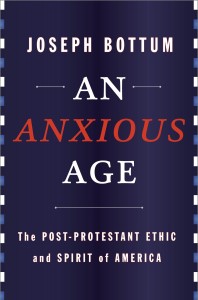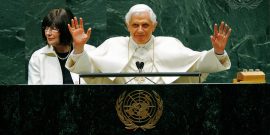Religious freedom is what makes America thrive, and freedom conservatism recognizes this.
America Adrift
For Joseph Bottum, America is a nation adrift. Historically, he says in An Anxious Age, American culture has been like a sturdy stool standing on the three legs of capitalism, democracy, and religion (especially Mainline Protestantism). The first two legs supplied entrepreneurial vigor and buy-in from “the people,” but Christianity gave America moral guidance and a sense of national mission. That three-legged stool served America well until about fifty years ago, when Mainline Protestantism began a protracted, massive decline.
Not that the spirit of the Mainline has left us, Bottum notes. Secular elites and the Mainline’s remaining representatives (one might cite Barack Obama as an example of the latter) bring an intense moralism into politics, but it is a moralism that is hesitant about making any specific claims about the will of God. Instead, left-wing post-Protestants borrow from old capital of the Mainline to assert that six sins remain the source of virtually all evils: bigotry, the arrogance of power, the corruption of justice, the madness of the mob, militarism, and class contempt.
Modernist preachers and theologians – led by the Baptist pastor Walter Rauschenbusch, whom Bottum provocatively calls “the single most significant figure since the Civil War…for he is the sign of the entire age” – drained the historic, theological distinctives of Christianity, focusing on the enlightened individual’s responsibility before God. This move, accomplished in the fundamentalist/modernist wars of the early twentieth century, set the stage for the collapse of the Mainline when its churches’ aims became indistinguishable from liberal advocacy groups and internationalist agencies.
The only viable replacement for the Mainline, in Bottum’s view, was traditional Catholicism, the kind best illustrated by John Paul II (the most admired figure in the book). Although the older ethnic Catholicism that dominated America’s cities through the mid-twentieth century went into decline at the same time as the Mainline, some Americans adhered to, or converted to the deeper Catholicism identified by Bottum. Only Catholicism seemed to offer the kind of spiritual depth and philosophical cohesion to give them grounding in post-Protestant America. Avery Dulles best illustrates these converts. Dulles came from a venerable Mainline family, but by the time he arrived at Harvard in the 1930s, he had become an agnostic. But he improbably became drawn to Catholic thought as a system that gave “a more complete account of the world than other philosophical systems.” He was received into the church and, after World War II, joined the Jesuits.
In an engaging if somewhat disorienting move, Bottum pairs his analysis of representative figures like Rauschenbusch and Dulles with semi-fictional composite figures representing the post-Protestant secular “Poster Children” and the “Swallows of Capistrano,” meaning those who stayed within, or who entered the church as a refuge from post-Protestant America. The Poster Children are secular yet puritanical about everything from food choices to the (self-contradicting) ethic of non-judgmentalism. The Swallows are represented by “Eleanor Portman” of New York City, who converted to Catholicism at Dartmouth, and “who demands that this world – the universe, creation, life, truth, beauty – makes sense.” Eleanor’s faith is serious and intelligent, as she is drawn to the idea of Catholicism, and the riches of its tradition.
As attractive as it is for some in America sans Mainline, however, Bottum believes that Catholicism has been unable to become a viable alternative to the Mainline. Part of the reason is that the Catholic Church has floundered organizationally, Bottum believes, especially in its inexcusable actions and obfuscations in the priestly sexual abuse crisis. Another aspect of this failure, of course, has to do with simmering hostility toward Catholicism in post-Protestant America. The last thing that the Poster Children want is a religious organization with a massive international bureaucracy which will not ordain women, marry homosexuals, or endorse abortion-on-demand. Yes, the Catholic intellectual tradition (and perhaps the Holy Spirit) can attract the Swallows, but for rank-and-file post-Protestants, an implicit anti-Catholicism is something like a core tenet of their creed. (Of course, the Poster Children have no problem with Catholics, per se, especially those who adopt Mario Cuomo’s infamous bargain on abortion of “personally opposed” but publicly supportive.)
So the Mainline has nearly vanished, and in spite of the courageous leadership of John Paul II, the clergy sex abuse crisis has squandered whatever chance that Catholicism had of standing in as America’s third leg of the stool. All this makes for an interesting story, enhanced by Bottum’s intriguing style. But from the perspective of this reviewer (an evangelical Baptist in Texas), Bottum seems strangely dismissive of the conservative Protestant factor in the story of American religion and culture in the past half-century. Sure, he mentions evangelicals occasionally (without an index it is difficult to know how often), but to Bottum, they do not seem to be a serious alternative, either as the third leg by themselves, or as the third leg in alliance with traditional Catholics and other conservative people of faith. I am certain that Bottum does not see evangelicals as a feasible third leg, but unlike Catholicism, he does not bother to explain why. Nor does he stop to explain why the cultural union represented by Evangelicals and Catholics Together, spearheaded initially by the late Richard John Neuhaus and the late Charles Colson, had “failed” as of the 2012 elections.
About all the explanation we get with regard to evangelicals’ viability is that they “lack the intellectual and institutional resources to replace the dying Mainline denominations.” Surely this requires a bit more unpacking? Certainly, when viewed from a global and historical perspective, evangelical Protestants lack the depth of tradition and institutional legacy of Roman Catholicism. But from the beginning of the evangelical movement in the eighteenth century, as well as the beginning of the Reformation in the sixteenth, many Protestants have drawn upon what they saw as the best of the tradition of the church, especially Augustine and those who followed in his wake. Just because a resource or writing is Catholic in origin does not mean that evangelicals cannot appropriate it.
Moreover, Bottum’s sharp distinction between Mainline and evangelical does not quite work. Especially the Baptist and Methodist churches were, at the time of their origins, evangelical. Much of the Mainline leadership turned modernist and liberal over the course of the twentieth century, but there are still legions of orthodox “Mainline” Christians in America, many of whom are working to advance traditionalist renewal within the Mainline denominations. The United Methodist Church, for example, beat back attempts at its latest quadrennial global assembly to liberalize church policy on sexual morality, a conservative stand keyed by the votes of non-American delegates. Traditionalist Anglicans are likewise aligning with African and other non-western dioceses. In other words, the Mainline may not be quite as dead as Bottum suggests, and the future of some of these denominations may feature a return to their evangelical past, in cooperation with global allies.
But what of evangelicalism per se? Is it as institutionally and intellectually weak as Bottum suggests? Viewed from the perspective of politics, it certainly is flaccid. Outside of the Republican primaries, evangelicals seem to have lost the political clout that they ostensibly commanded in the era of the Moral Majority. But institutionally, there are considerable signs of evangelical life, especially as compared to the Mainline institutions. Conservative seminaries dominate lists of the largest Protestant institutions for pastoral training, with Southern Baptists controlling five of the top ten largest seminaries in America. Catholic seminary enrollment is also healthier now than it has been in a quarter-century. We do not want to overstate this health, of course, as both Roman Catholics and Southern Baptists have seen overall patterns of denominational decline that some regard as early signs of a collapse in adherents similar to that experienced by the Mainline.
Nevertheless, there is also reason to believe that the conservative Protestant tradition is intellectually healthier than it has been in decades. Nowhere has this vibrancy been clearer than at Catholic Notre Dame (my Ph.D. alma mater), where Protestant scholars including George Marsden, Alvin Plantinga, and Mark Noll, have not only bolstered the university’s academic reputation, but have helped keep Notre Dame more closely tied to its religious mission. (With Plantinga and Marsden having retired, it will be interesting to see if Notre Dame chooses to maintain its evangelical niche in the future.) Outside the academy, perhaps one of the most heartening recent developments was the Southern Baptists’ Ethics and Religious Liberty Commission appointing Russell Moore, an articulate and media-savvy scholar from Southern Baptist Theological Seminary, as its new head, taking the lead of perhaps the most visible agency of the nation’s largest Protestant denomination.
And what of the evangelical-Catholic synthesis? That cooperation began in the 1970s as a reaction against the social revolutions of the era, and against Roe v. Wade. It is not clear to me why Bottum thinks that the evangelical-Catholic union has “failed.” If gauged by political successes, especially defending traditional marriage or the sanctity of life, then the record is certainly mixed. But in advancing compelling arguments for life, religious liberty, the historic institution of the family, or the value of faith-based arguments generally, there are many successes.
Beyond the scholars at Notre Dame, one thinks of the influential work of Princeton’s Catholic scholar Robert George, recently named the chairman of the U.S. Commission on International Religious Freedom. Or the late Jean Bethke Elshtain, who taught at the University of Chicago, and who at the end of her career was also Visiting Distinguished Professor at Baylor University, my own institution. Baylor has seen a remarkable intellectual flowering in recent years, with prominent scholars representing Mainline, evangelical, and Catholic traditions, including Philip Jenkins, David Lyle Jeffrey, and Francis Beckwith, to name just a few. I could go on, but the point is that the “Swallows,” both of the Catholic and the evangelical varieties, have intellectual places to nest. Those places are often populated by sympathizers of Evangelicals and Catholics Together, and similar, broadly orthodox movements.
None of this would suggest that evangelicals, or movements like Evangelicals and Catholics Together, can achieve the kind of cultural influence that would allow them to replace fully the Mainline as the third leg of America’s stool. Believers in America certainly wish our nation well, and may look back fondly at our nation’s earlier eras of great theological and historical depth, cultural cohesion, and moral seriousness on many, if not all issues. But believers cannot ultimately be responsible for America. If ours has become a profoundly rootless, self-absorbed culture because of the absence of religious and ethical grounding, all the churches can do is offer a winsome testimony of Christian answers that have been coherent and compelling for two thousand years. Those with ears to hear, will hear.



